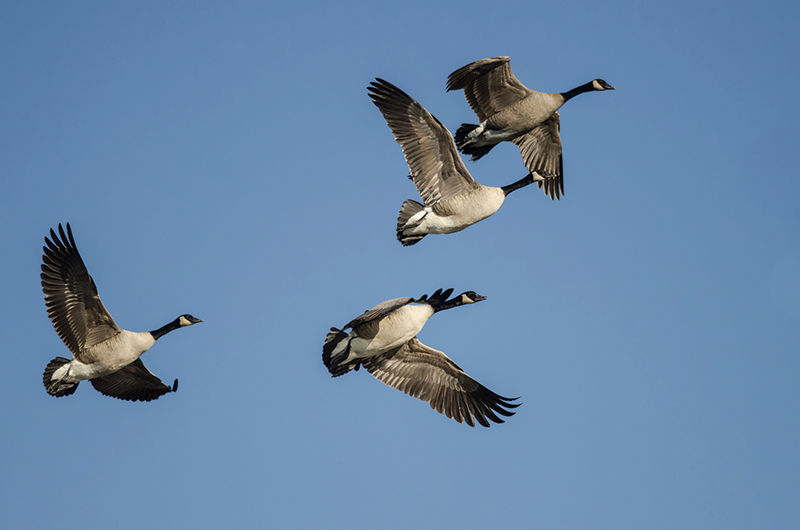For many, the fall months provoke no thought to swap a fishing rod for a shotgun. The five-week Martha’s Vineyard Striped Bass and Bluefish Derby, now in its seventy-third year, is the focus of attention. But as summer turns to fall and Island salt marshes take on a golden hue, a dedicated fraternity of waterfowlers look skyward.
Decades before the Derby was a glimmer in the eyes of Nat Sperber, a public relations guy for a then-new ferry company who hit upon the idea of a fishing tournament to boost the fall tourist economy, waterfowling was the primary sporting activity. In the early part of the twentieth century, wealthy seasonal visitors regularly enjoyed quality sport hunting for geese and ducks. Hunting camps and duck blinds, most now replaced by luxury homes, overlooked the marshes and coves of salt ponds from Chappaquiddick to Aquinnah.
Islanders, meanwhile, hunted to put food on the table. They shot over wooden decoys carved on long winter evenings – bluebills, redheads, and black ducks mostly, according to the late West Tisbury artist Stan Murphy, author of Martha’s Vineyard Decoys (Godine, 1978), a gem of a book long out of print. These long-gone gunners would have been amused to hear their decoys described as art, he wrote: “They were made only to toll the birds, not to leave for posterity the evidence of man’s ability to create from common materials things of truth and occasional great beauty.”
My introduction to the beauty of watching the sun rise while seated in a makeshift duck blind began with the $50 purchase of a rambunctious black Labrador retriever puppy named Tashmoo, whom I got from Aquinnah landscaper Steven Yaffee. Tashmoo inspired me to be a duck hunter.
One cold morning Tashmoo and I accompanied Cooper “Coop” Gilkes of Edgartown on a duck-hunting trip to Chappaquiddick. Tashmoo, with no prior introduction to the sport, plunged into Cape Pogue Bay after a whistler Coop had knocked out of the sky. It was inspirational to watch a Lab respond to every urge in his DNA that told him there is nothing more fun than to run out of a duck blind and retrieve a duck. There was nothing in my genetic makeup to help me be a hunter, but as the years passed I did my best to become better at it.
One day, at Book Den East in Oak Bluffs, I came across Duck Hunting (A.S. Barnes), by John G. MacKenty of Edgartown. The 1953 book provided practical advice and a glimpse into the Island lifestyle in the early fifties. MacKenty owned much of Kanomika Neck on Edgartown Great Pond. A New Yorker by birth, he hunted nearly every day in season and enjoyed the companionship of Islanders. In the first chapter, entitled “Why do we go hunting?” he describes the “relaxation and anticipatory tension,” the “companionship,” and “the complete opportunity to be one with nature at the time of its most charming and delightful mood – dawn.”
MacKenty took his choice of companions seriously. Referencing a technique for refining ore, he advised that one “pick your gunning companion with the same care and forethought you would employ in selecting a business partner, except that in the testing, I suggest the employment of a finer mesh screen and a stronger acid.”
It’s good advice. Sitting in a blind waiting for a bird to fly within range provides time to contemplate life, or, when sharing a blind with a friend, for good conversation.
When Tashmoo was in his prime we hunted The Trustees of Reservations’ Long Point Wildlife Refuge in West Tisbury. Now best known for its beach, the property has its origin in the Tisbury Pond Club, a private hunting preserve established by a group of wealthy businessmen in 1912 with an initial purchase of 470 acres of land. In 1977, in an example of generosity rooted in the history of American sportsmen, Frederick Blodgett, Carl Gilbert, and William Rodgers, the remaining three members of the club, donated the land to The Trustees.
In a conversation before he died in 1999, Blodgett, then ninety-five years old, told me that despite offers of a great deal of money, he and the remaining club members wanted to ensure that the property would be “forever for the public and would never be developed.”
Development and a warming climate have curtailed the once bountiful flights of ducks. The exception is the non-migratory geese that foul water bodies and damage crops. As a result, the state Division of Fisheries and Wildlife (MassWildlife) provides an early goose hunting season, which this year begins on September 4 and ends September 21. The daily bag limit is a whopping fifteen geese. The early (October 12–October 20) and late (November 12–January 10) duck seasons allow for two geese and six ducks.
Although state law allows for fishing, fowling, and navigation between the low and high water mark, reaching the shoreline is often problematic. Properties owned by the land bank and The Trustees provide the best opportunities for waterfowlers. For more information on duck and goose hunting regulations, go to the MassWildlife website.





